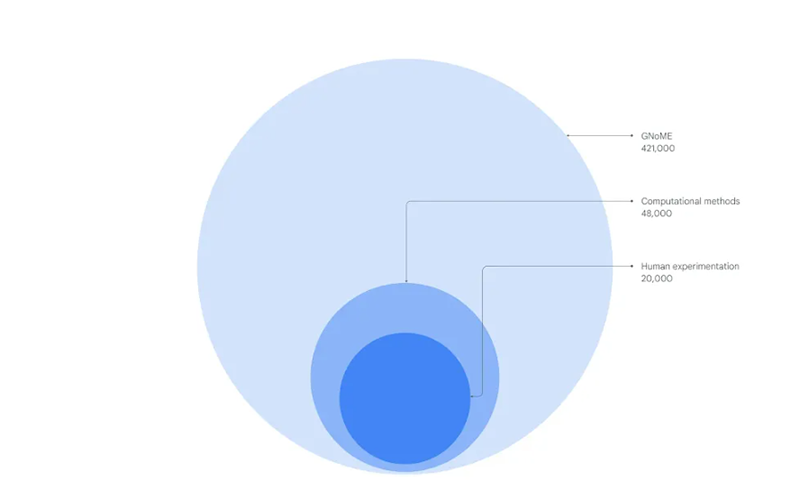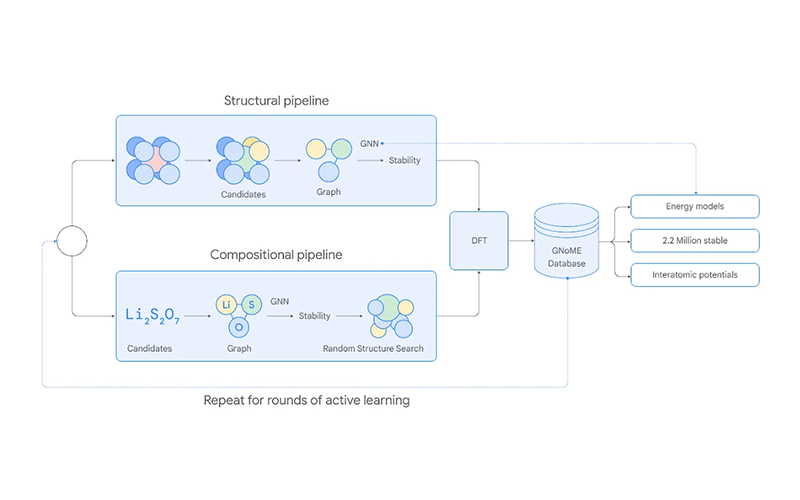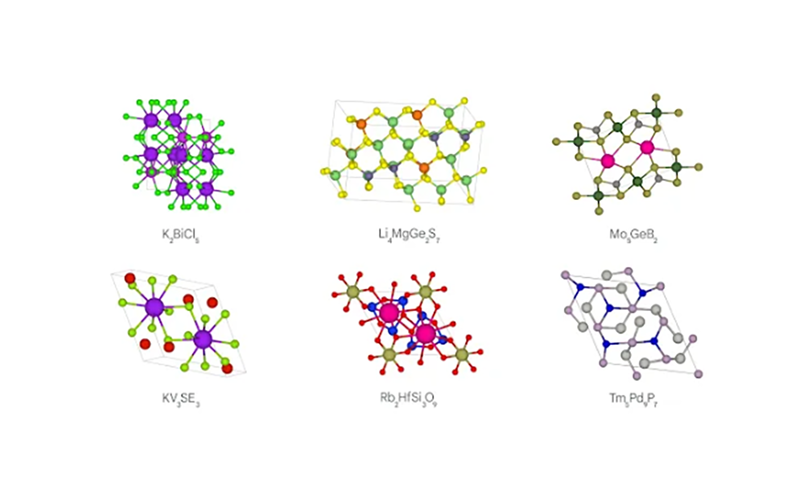Google GNoME deep learning reveals millions of new materials
The AI tool Google GNoME has identified a remarkable 2.2 million new crystals, including 380,000 stable materials, potentially powering future technological advancements.
These inorganic crystals are crucial for a range of modern technologies, from computer chips and batteries to solar panels. Stability in these crystals is vital to prevent decomposition, a challenge often requiring extensive experimentation.
A recent publication in Nature highlights the discovery of these 2.2 million new crystals, a knowledge expansion equating to nearly 800 years. Graph Networks for Materials Exploration (GNoME) is introduced as a novel deep learning tool that significantly enhances the discovery process by predicting the stability of new materials.
GNoME has exponentially increased the number of known technologically viable materials. Among its 2.2 million predictions, 380,000 are deemed most stable, positioning them as strong contenders for experimental synthesis. These materials hold promise for developing transformative future technologies, such as superconductors for supercomputers and advanced batteries to improve electric vehicle efficiency.
GNoME demonstrates the capacity of AI in discovering and developing new materials on a large scale. Notably, 736 of these newly discovered structures have been independently created by external researchers in concurrent studies. Additionally, in collaboration with Google DeepMind, researchers from the Lawrence Berkeley National Laboratory have published a complementary paper in Nature, showcasing how AI predictions can facilitate autonomous material synthesis.
The predictions from GNoME are now accessible to the wider research community. Contributing 380,000 materials predicted to be stable to the Materials Project, this initiative is currently processing these compounds for inclusion in its online database. This effort aims to propel research in inorganic crystals and highlight the role of machine learning tools in guiding experimental research.
Accelerating materials discovery with AI

Approximately 20,000 crystals, experimentally catalogued in the ICSD database, have been verified as computationally stable. This number has been augmented to 48,000 stable crystals through the application of computational methods, utilising resources such as the Materials Project, the Open Quantum Materials Database, and the WBM database. The AI tool GNoME represents a significant leap in this field, expanding the total number of known stable materials to an impressive 421,000. This advancement marks a considerable increase in the range of materials available for technological development and research, showcasing the profound impact of computational approaches in material science.
Historically, scientists sought novel crystal structures through a process of modifying known crystals or experimenting with new element combinations, a costly and time-consuming method often yielding limited outcomes. Over the past decade, computational techniques spearheaded by the Materials Project and similar initiatives have facilitated the discovery of 28,000 new materials. However, these AI-guided approaches previously encountered limitations in accurately predicting experimentally viable materials.
The advent of GNoME marks a significant breakthrough, uncovering 2.2 million materials, an amount equating to approximately 800 years of accumulated knowledge. This achievement represents a monumental expansion in both the scale and precision of material predictions.
Among these discoveries are 52,000 new layered compounds akin to graphene, which hold the potential to revolutionise electronics through the development of superconductors. Prior to this, only about 1,000 such materials had been identified. Additionally, GNoME identified 528 potential lithium-ion conductors, a twenty-fivefold increase over previous studies, offering advancements in rechargeable battery performance.
The release of structural predictions for 380,000 materials, which hold the highest likelihood of successful laboratory synthesis and practical application, is a significant step forward. To be classified as stable, a material must not decompose into forms with lower energy. For instance, carbon within a graphene-like structure is more stable than in diamond form. These materials mathematically reside on the convex hull. GNoME's project has unveiled 2.2 million new crystals that meet current scientific standards of stability and fall below the convex hull of earlier discoveries. Of these, 380,000 are deemed most stable, positioned on the "final" convex hull, establishing a new benchmark for material stability.
GNoME: Harnessing graph networks for materials exploration

GNoME employs two distinct pipelines to identify low-energy (stable) materials. The first, known as the structural pipeline, generates candidate materials with structures analogous to already known crystals. The second, the compositional pipeline, adopts a more randomised method, focusing on chemical formulas to create potential materials. The outputs from both pipelines are then rigorously assessed using established Density Functional Theory (DFT) calculations. These results are subsequently integrated into the GNoME database. This process of evaluation and integration plays a crucial role in informing subsequent cycles of active learning within GNoME, continually enhancing the tool's effectiveness in discovering stable materials.
GNoME is a state-of-the-art graph neural network (GNN) model. The input data for GNNs take the form of a graph that can be likened to connections between atoms, which makes GNNs particularly suited to discovering new crystalline materials.
Initially, GNoME was trained using data on crystal structures and their stability, sourced from the publicly accessible Materials Project. This training enabled GNoME to not only generate novel crystal candidates but also to predict their stability. To evaluate the predictive accuracy of our model across various training phases, we consistently employed Density Functional Theory (DFT) calculations. DFT is a well-established computational method in disciplines such as physics, chemistry, and materials science, crucial for understanding atomic structures and, by extension, assessing crystal stability.
The implementation of an 'active learning' approach significantly enhanced GNoME's performance. This method involved GNoME generating predictions for the structures of new, stable crystals, which were then verified using DFT. The high-quality data obtained from these tests was re-incorporated into the training process, refining the model's predictive capabilities.
Our research succeeded in elevating the material stability prediction rate from approximately 50% to 80%, a benchmark previously set by the most advanced models in the field. Moreover, we achieved a substantial improvement in our model's efficiency, increasing the discovery rate from under 10% to over 80%. Such enhancements in efficiency could markedly reduce the computational resources required for each discovery, signifying a major advancement in the field of material science research.
AI ‘recipes’ for new materials
The primary objective of the GNoME project is to reduce the expenses associated with the discovery of new materials. This initiative has already demonstrated significant real-world impact, as evidenced by external researchers independently synthesising 736 materials identified by GNoME in their laboratories. This achievement underscores the accuracy of GNoME's predictions in identifying stable crystals.
In an effort to further advance scientific research, the complete database of crystals discovered by GNoME has been made available to the research community. By providing scientists with access to this extensive catalogue of potential material 'recipes', the project aims to facilitate further testing and synthesis of these materials. This initiative is expected to assist researchers in identifying and developing the most promising new materials, thereby contributing to the broader field of material science.

Following the culmination of our recent discovery endeavours, a comprehensive review of scientific literature revealed that 736 of the materials we identified computationally have been independently synthesised by research teams worldwide. Among these, six notable examples span a diverse range of materials. These include a unique Alkaline-Earth Diamond-Like optical material, identified as Li4MgGe2S7, and a material with potential as a superconductor, labelled Mo5GeB2. These findings not only validate our computational predictions but also highlight the global reach and impact of our research in advancing material science.
The swift development of new technologies using these crystals hinges on the capability to manufacture them effectively. A paper authored by our collaborators at Berkeley Lab highlights a significant advancement in this area. Researchers demonstrated that a robotic laboratory could expedite the creation of new materials through automated synthesis techniques. Leveraging materials from the Materials Project and stability insights provided by GNoME, this autonomous lab was able to formulate new recipes for crystal structures. Impressively, it successfully synthesised over 41 new materials, thereby paving the way for innovative avenues in AI-driven materials synthesis. This development marks a significant stride in the field, showcasing the practical applications and potential of AI in revolutionising material production.
New materials for new technologies
For a sustainable future, the development of new materials is crucial. GNoME has made a significant contribution in this direction by discovering 380,000 stable crystals. These crystals are key to fostering greener technologies, ranging from improved batteries for electric vehicles to superconductors for more efficient computing.
Our research, along with the collaborative efforts at the Berkeley Lab, Google Research, and various global teams, has demonstrated the immense potential of AI in guiding the discovery, experimentation, and synthesis of materials. We are optimistic that GNoME, in conjunction with other AI tools, has the capability to revolutionise the field of materials discovery, significantly impacting the trajectory of future advancements in this area.










